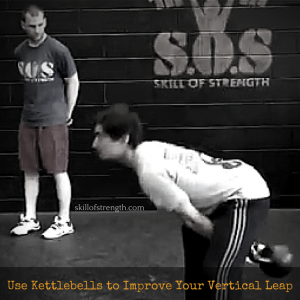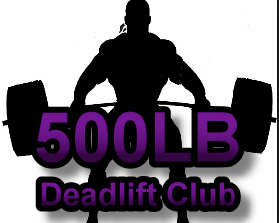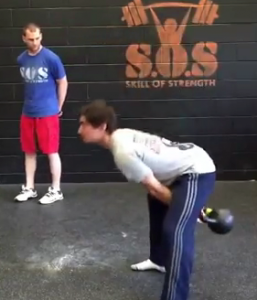Did you know you can train with kettlebells to increase your vertical leap? The kettlebell swing, in particular, is a great exercise for many reasons, but today we’ll discuss how practicing and nailing this exercise can help you improve your vertical leap.

The vertical leap is used as a measure for athleticism among high school, collegiate and professional athletic programs. It is one of the most common tests an athlete will have to go complete during his/ her athletic career. If it is a pre-season camp, a combine, or even a collegiate exiting screen, the oh-so-familiar vertical leap is sure to show up to the party.
Here are 5 reasons why kettlebells are so effective at increasing your vertical leap.
1. Improves Lower Body Explosiveness (Strength vs. Power)
The vertical leap is not a strength test. Instead, and more specifically, it is a test of lower body explosiveness. It is necessary for an athlete to generate force extremely fast in order to leap off the floor. Keep in mind, deadlifting 500lbs is great, and it will give you a lot of strength potential, but moving a barbell slowly is not necessarily going to teach your hips how to move explosively.

2. Practice a Common Movement Pattern – The Hip Hinge
When training with kettlebells an athlete is not only developing strength and power in the legs but they are doing so using the specific motor pattern used in the vertical leap.

3. Generate More Force Production with the Stretch Reflex
The loading part of the vertical leap and the down swing of the kettlebell swing rapidly stretch the hamstring. This rapid stretch generates more force production when followed by the rapid hip extension of the “jump” of the upswing of the kettlebell.

4. Improved Stability
Kettlebell training requires a lot of core activation. Activating the core during the kettlebell swing helps stabilize the pelvis. By stabilizing the pelvis in the swing and the vertical leap, the power an athlete is able to generate in his/her legs is more effectively and efficiently transferred to the hips. Think of it this way, more energy is directed to the leap instead of leaking else where.

5. Improved Mobility
Mobile athletes will be able to get into a more optimal position at the bottom of their leap, recruiting and utilizing as much of their hamstrings, glutes and quads as possible.
If athletes have limited hip mobility and hamstring flexibility, as they sit back into the loading position they will be forced to either stop where their end range of mobility has been reached, or recruit mobility from somewhere else. Getting mobility elsewhere, for example, from their back, is not going to have the same effectiveness as being able to stretch the hips and hamstrings further.
Check out the video below for more information on how and why you can use kettlebells to increase your vertical leap.
Takeaways
It’s appropriate to implement kettlebell swings into athletes training programs once they have mastered the deadlift.
I would recommend doing a high number of sets with no more then 10 reps at a time, so the athlete is not getting fatigued, which will negatively impact his technique.
Whether you have ventured into the world of sports performance, or have spent a lot of time developing your strength, take advantage of kettlebell swings to help you use your strength more effectively during vertical leap test time.
As always, we want to hear your opinion, leave comments below!
